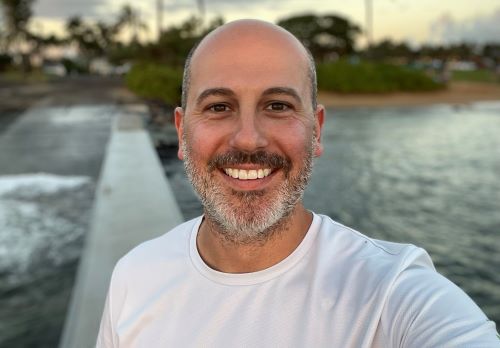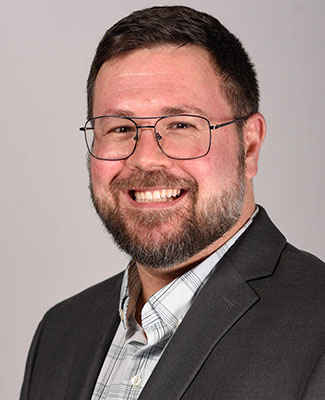Enter your email to receive the CareQuest newsletter:
August 13, 2024
Robert MacArthur, DMD, is well aware of how a patient could feel uncomfortable sitting in a dental chair.
“Dentistry is an extremely invasive profession,” MacArthur says. “It requires a lot of trust, and it’s really humbling when I put myself in the dental chair at least twice a year just for a regular cleaning. It’s good to be reminded of how invasive it can be.”
MacArthur identifies as a cisgender gay white male, so he also understands that being part of the LGBTQIA+ community can make going to the dentist even more stressful and uncomfortable — and the value of having a dentist you can trust.

“Patients have come up to me after an appointment and said it’s important to find an inclusive dentist where they feel comfortable enough to reveal their complete medical history, which includes their sexual identity and orientation. And I can relate with them, as it took me a while to find an inclusive primary care provider,” he says. “Some patients might not disclose this information for fear of being turned away or maybe being outed to other people, especially if it’s a small community or if they are not ready to come out.”
Although he’s a member of the LGBTQIA+ community, MacArthur says there’s still a lot he can learn about creating a space where patients — especially from underserved communities — feel welcome. So, when his boss sent over an email with a link to a CareQuest Institute webinar about creating inclusive environments for the LGBTQIA+ community, he was more than happy to attend.
“I admit there was some terminology, proper pronoun usage, and different forms of gender expression I needed to learn more about,” he says. “I was curious and trying to stay abreast of current terminology.”
Education from the webinar, MacArthur knew, would be immediately applicable — and not just for him. He took what he learned from the session and passed it along to his family, which includes several professionals in the medical field.
“Just like with Pride Month in general, the more awareness we have, the more likely we can break down barriers to care, provide more inclusive care, and create a more trusting environment,” he says.
The Importance of Meeting Communities Where They Are
MacArthur grew up in rural Tennessee and worked in rural Alaska for the last eight years. For the past few months, he has worked as a dentist at the Boston Health Care for the Homeless Program. There, he provides medical and dental care for the unhoused.
“The organization does a fantastic job on being an inclusive work environment, but also equipping providers with continuing education to address care that is inclusive and addresses current issues,” he says.
Keeping providers aware of current issues was one of the goals of the webinar, which featured Harold Jennings Jr., RDH, MA, associate director at Plaza College, and Alex Barrera, DDS, director of dentistry at Avenue 360 Health and Wellness. Kasey Wilson, MSW, senior policy analyst at Community Catalyst, served as moderator. The trio covered topics ranging from the unique challenges and oral health inequities LGBTQIA+ communities face to applying inclusive language and best practices in daily patient interactions.

“I think there are some long-standing access issues that are associated with discrimination that the community faces,” says Jennings. “So, if we look at medicine, they’re [members of the LGBTQIA+ community] less likely to have health insurance. And so that also relates to dental care as well. It’s kind of across the board in that they may personally experience more fear, and through the discrimination that they face, experience barriers to care.”
Jennings says because of that discrimination, it’s a dental professional’s responsibility to meet patients where they are to help overcome those barriers.
“Coming out isn’t an event,” Jennings explained during the webinar. “It’s a process. So, we should be aware of that in these humanistic conversations that we have and the relationships that we build with our patients.”
Jennings says one way to do that is through inclusive language — for example, using words like “transgender” instead of “transsexual” and “lesbian” or “gay” instead of “homosexual,” and not assuming what pronouns a person uses, something that resonated with MacArthur.
“It’s leading the conversation and saying to patients, ‘Hi, my name is Dr. Mac, or Robert, and I use the pronouns he/him. What pronouns do you prefer?’,” MacArthur says. “Or perhaps another approach that wouldn’t put someone on the spot could be, ‘If you are comfortable with talking about the pronouns you prefer to use, please let me know.’”
During the webinar, Jennings also explained how it’s okay to ask when you don’t know what pronoun to use, and if you make a mistake, apologize and move forward.
“And the other thing that I really hope is a takeaway is that allyship implies action,” Jennings says. “So just agreeing with what someone is saying doesn't make you an ally, not holding biased views doesn't make you an ally. An ally is someone who is advocating for the community.”
Jennings says even though the significance of barriers to accessing care for LGBTQIA+ people needs to be further researched, knowing that his teachings made an impact on even one person makes all the difference to him.
“I think it’s wonderful to hear that people responded really well to the presentation, specifically around language,” Jennings says. “If we want to stay involved, we also have to stay engaged in language in accepted and approved terms. And that’s not just for this [LGBTQIA+] community. It’s for all communities.”